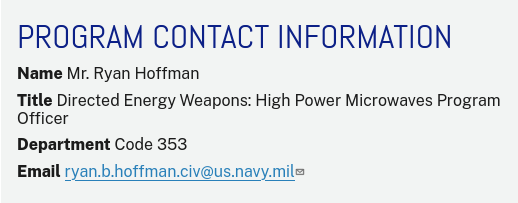Herzlich Willkommen zur neuen Sendeserie und zur friedlichen und gewaltfreien Revolution des Souveräns. Max Pucher diskutiert in dieser Sendung mit Obstlt Ing. Harald NEJDL über die Angst vor dem 3. Weltkrieg, warum die EU von einem Friedensprojekt zu einem Kriegstreiber geworden ist, wieso das Pulverfass Naher Osten für uns weniger ein Problem sein wird, und welche Optionen Selenskjy und Russland in naher Zukunft haben.

Directed Energy Weapons: High Power Microwaves
Directed energy weapons (DEWs) are defined as electromagnetic systems capable of converting chemical or electrical energy to radiated energy and focusing it on a target, resulting in physical damage that degrades, neutralizes, defeats, or destroys an adversarial capability. Navy DEWs include systems that use high-energy lasers (HEL) that emit photons and high-power microwaves (HPM) that release radiofrequency waves. The U.S. Navy uses DEWs for power projection and integrated defense missions. The ability to focus the radiated energy reliably and repeatedly at range, with precision and controllable effects, while producing measured physical damage and/or mission defeat, is the measure of DEW system effectiveness. Conversely, capabilities to increase the resilience or survivability of platforms or Sailors from DEW threats are part of the Counter Directed Energy Weapons (CDEW) program.
Research Concentration Area: High Power Microwaves (HPM)
HPM weapons create beams of electromagnetic energy over a broad spectrum of radio and microwave frequencies in both narrow-band (bandwidth ~< 1%) and wide-band (bandwidth >> 1%) with the intent of coupling/interacting with electronics within targeted systems either by causing damage or temporary disruption from which the system cannot self-recover in time to accomplish its mission.
Directed energy HPM provides the U.S. Navy many benefits including speed of light attack, deep magazines and modest electrical power from the host platform. Additional benefits include broad beams for wide area coverage with comparatively simple targeting, and the ability to be used in congested (urban) environments where kinetic weapons may have constricted use.
Present focus areas are twofold. First is to explore technologies, including effects mechanisms, which explore opportunities to engage targets at higher frequency (X through K bands) and, thus, greater directivity. Second is the reduction of required power on target through the exploration of novel HPM systems that provide rapid on-demand shot-to-shot waveform parameter adjustability. Enabling areas of research might include development of small sources with sufficient control over the waveform such that they can be arrayed. They might also include high power amplifiers and higher frequency variants of existing concepts, both beam driven and solid state.
Additional research focus areas should include research into the coupling of high power RF to, its interaction with, and its effects upon electronic systems. The goal of this is to enable the development of predictive effects tools. It should also include the use of waveform parameter adjustability with the goal of maximizing effects on electronics. Finally, developments of any sort that lead to significant (> factor of 2) improvements in size, weight, power and cost of existing systems will be considered.

- Exploration of the capabilities and limitations of conventional HPM beam driven sources to optimize output power at X band through K band including not only consideration of (potentially novel solid state and) vacuum electronic-based HPM sources, but also the supporting pulsed power, antennas and other subsystems.
- Solid state HPM sources that provide shot-to-shot waveform parameter adjustability (bandwidth, frequency, pulse width, envelope, etc.) from L band through K band that are able to rapidly adjust not only to rapidly changing assessment of target vulnerabilities, but also to real-time sensing of optimal coupling paths.
- Computer simulation and modeling codes to enable the next generation of HPM sources and amplifiers, both beam driven and solid state. Focus of this code development will be on modeling of bulk materials and material interfaces subjected to high power densities and plasma interactions.
- Theory and analysis of HPM effects that merges approaches to assess efficient coupling with an understanding of the various mechanisms by which coupled RF energy can have an effect on target systems of interest. This could include RF coupling and modeling tools to capture both complex EM wave interactions with electronics and associated enclosures, and electronic component disruption.
- Novel antenna array concepts, high power beam steering techniques and distributed beam forming approaches
- Novel HPM sensors, instrumentation and algorithms are of interest for
- Experimental validation of coupling, interactions and effects
- Measurement of waveforms
- Diagnosing system performance
- Electronic battle damage indication (eBDI)
- Surrogate system electronics test capabilities


Review the DEW HPM Annual Reports:
- DEW HPM 6.1 Programs FY22 Annual Report
- DEW HPM 6.1 Programs FY21 Annual Report
- DEW HPM 6.1 Programs FY20 Annual Report
- DEW HPM 6.1 Programs FY19 Annual Report
- DEW HPM 6.1 Programs FY18 Annual Report

Schreibe einen Kommentar
Du musst angemeldet sein, um einen Kommentar abzugeben.